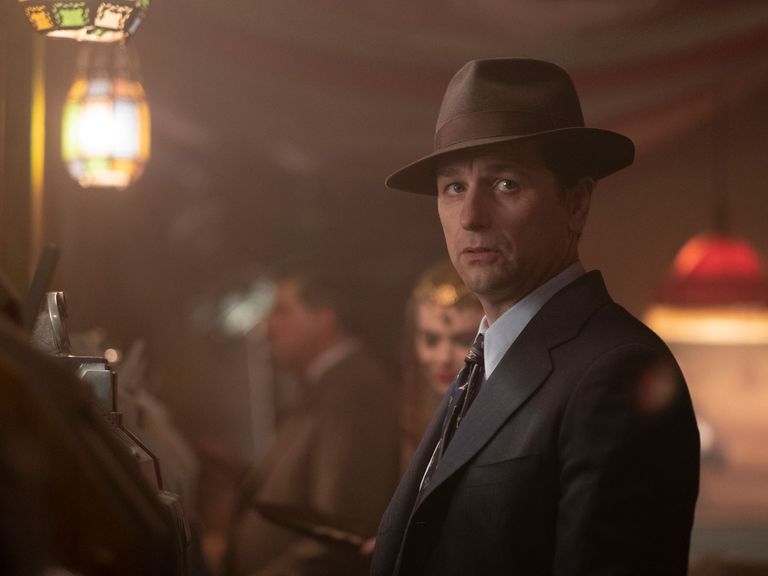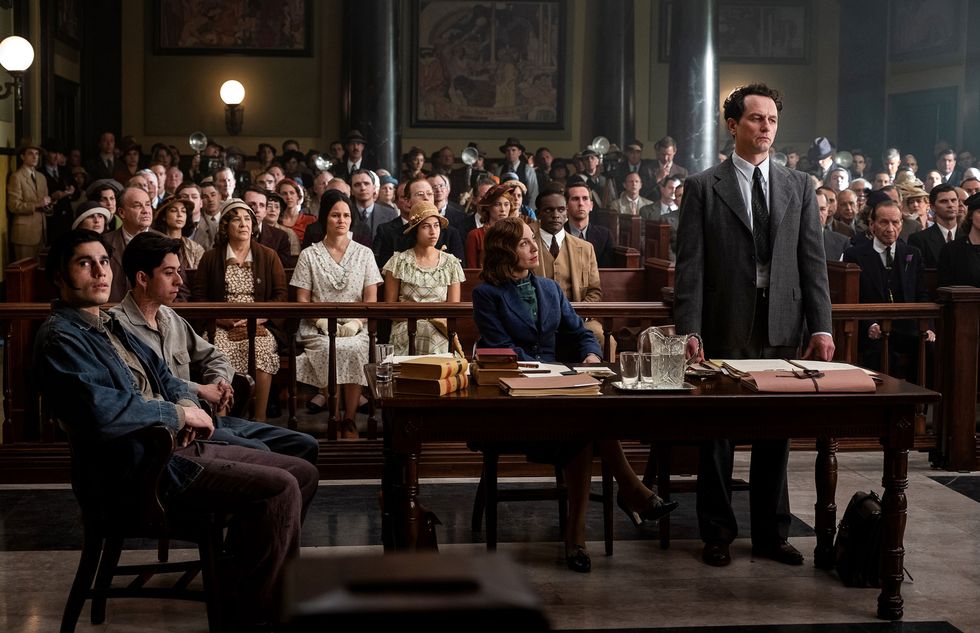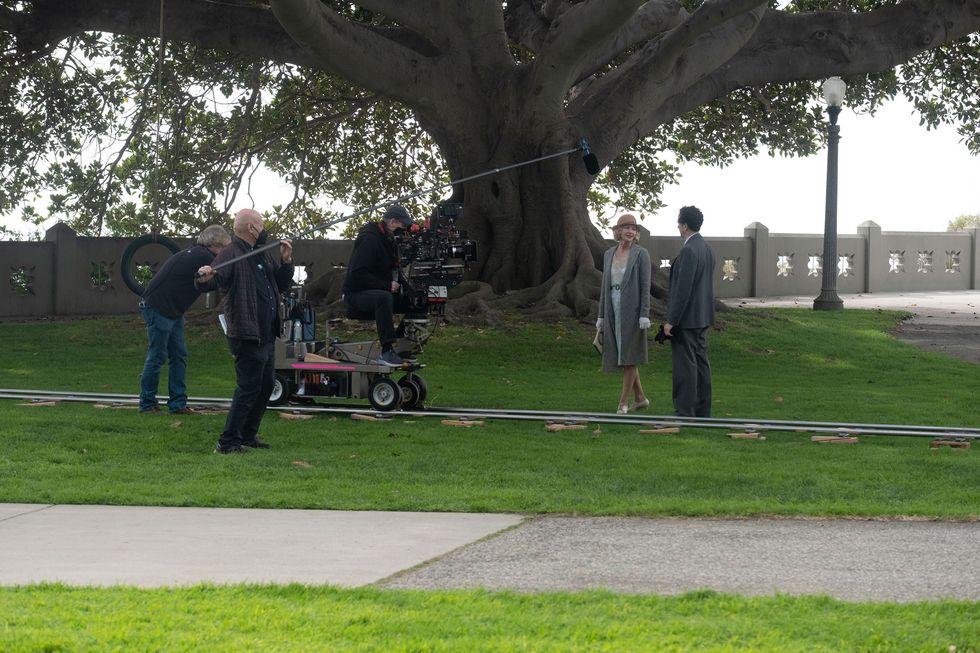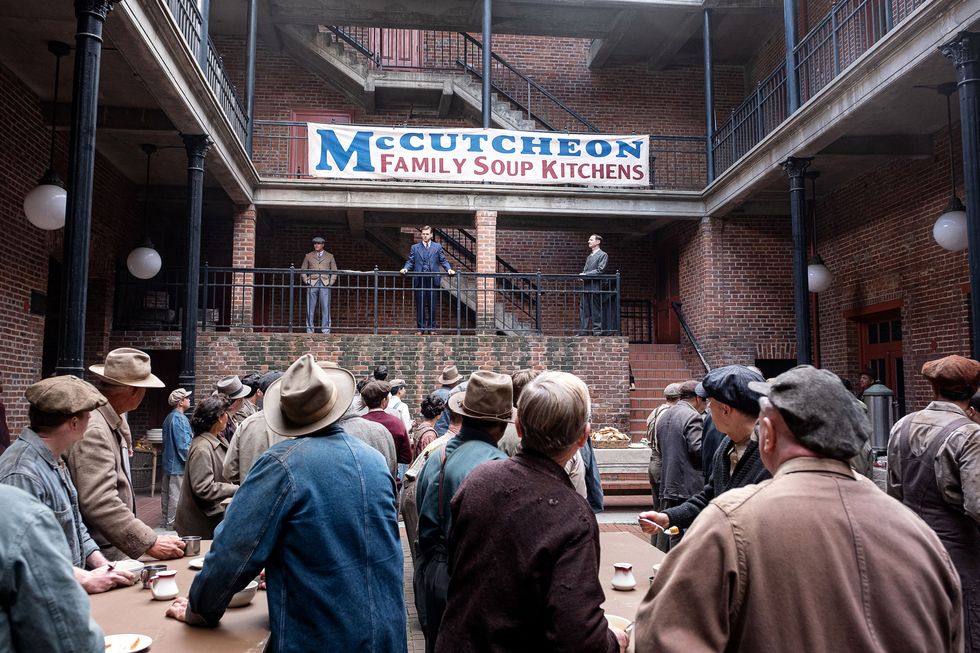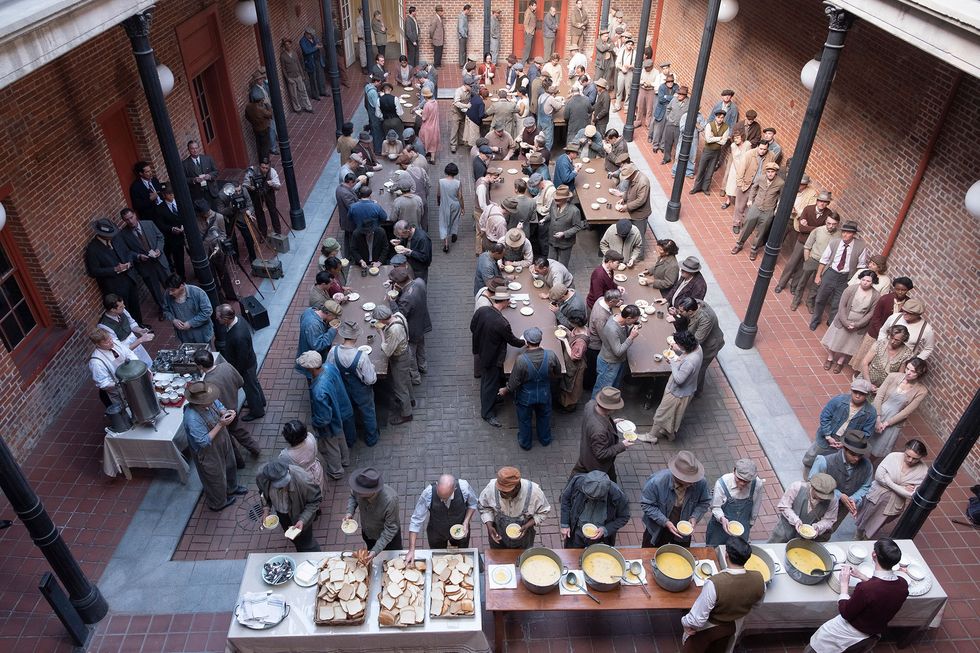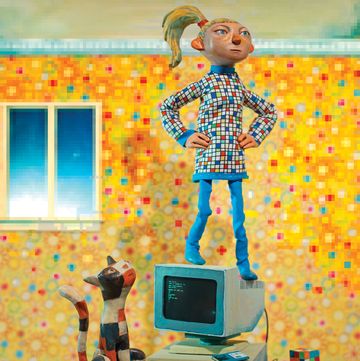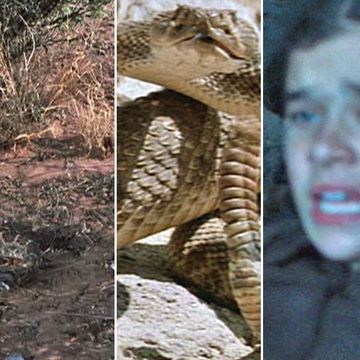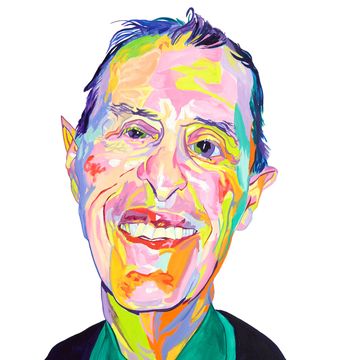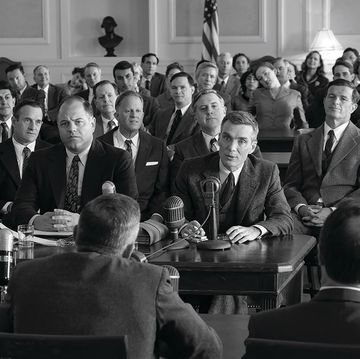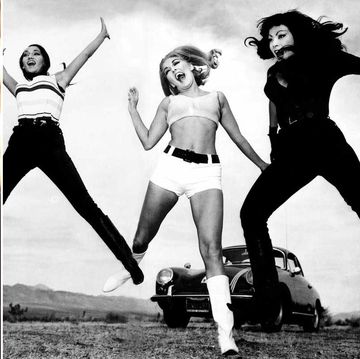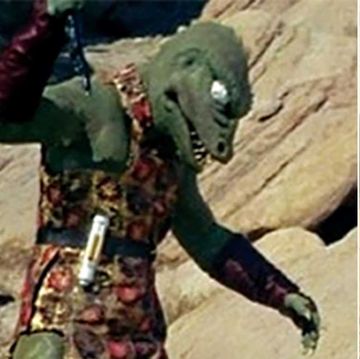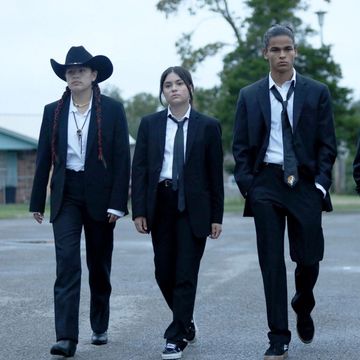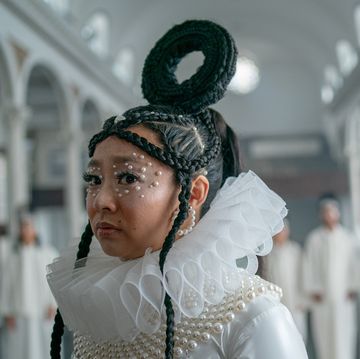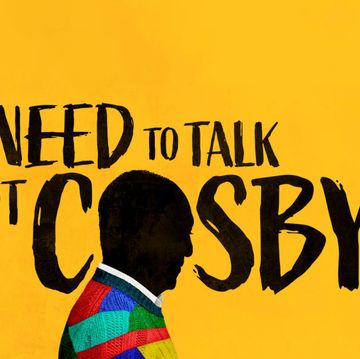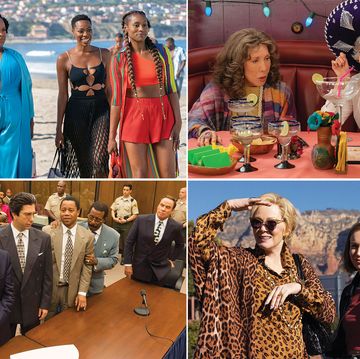What we do as historians is a low-tech version of time travel. Yellowed documents, old books, faded photographs—we sift them into tentative coherence as we peer into (and squint at) the past. Most of the time, we perform this work in archives, libraries, offices, and our classrooms. Sometimes, though, the journey to the past feels real and palpable, as if an actual time machine had whisked us away.
This time-traveling vertigo seized both of us on a hot morning last June. We had shown up early for a day of shooting on season 2 of HBO’s Perry Mason at Warner Bros. Ranch in Burbank, then made our way through security, including ID checks and clipboard signatures. We headed over to a courtroom on Stage 33. Rounding a corner, we went from 2022 to the 1930s. Just like that.
Dozens of extras milled about the lot as they received directions on what to do as gallery spectators in the scene, set in 1933 Los Angeles. Perry Mason and his loyal team were representing two brothers charged with capital murder. The extras were costumed so accurately that it was jarring, especially when one of them would reach for an iPhone or an N95 mask as they listened to their instructions. They held cigarettes and vintage cameras. Their shoes were snazzy, perfect for the era. In the courtroom itself, period books and ledgers rested on Mason’s counsel table and the court clerk’s desk. On camera and off, the clerk moved legal documents to heavy metal filing cabinets. Actor bailiffs stood at the ready. The sound of the gavel summoned everyone to attention; the actor judge announced his control of the courtroom and everyone in it, the two of us, off to the side and out of view, included.
“May truth always stand with the People,” proclaimed the stylized lettering atop the mural filling one wall of the faux courtroom. Murals like this one—products of the Works Progress Administration, active during the New Deal—once graced the walls of courtrooms and post offices all across the nation.
As historians as well as historical consultants, we could spin a tale of California using the images painted above us—the scenes of Indigenous and Spanish life, a ’49er carrying a sack, the tableau “culminating” in the boosterism of top-hatted white businessmen. But we feel the distance between so many of the narratives of California that follow what’s depicted on the wall and the types of historical arguments we engage in nowadays with our students, our peers, and, hopefully, the public. The courtroom mural’s sheer linearity—this led to this and this to that, as if ordained—is another way in which we part with earlier interpretations of our shared past (or pasts). The experience of trying to understand it all is thought-provoking, fun, and a little bit destabilizing all at once. We’re grateful that the discussions of today try to address (and take in) a wider cross section of American experiences and lives.
We’ve worked hard to help ground Perry Mason, the man (played by Matthew Rhys) and the show, in Great Depression–era Los Angeles. One of us had the privilege of being involved throughout season 1. Watching it, once the episodes had all made it through production and thence to television, was exhilarating, especially when a “historical Easter egg”—a (supposedly) fat-reducing, virility-inducing electric belt invented by none other than Gaylord Wilshire, of, among other things, Wilshire Boulevard fame—that had been suggested to the writers actually showed up. Season 2’s work was equally interesting and fun. The two of us engaged in energetic back-and-forth encounters with the writing and production teams over the better part of a year. Emails showed up at all hours of the day and night. “Do you know anything about nighttime performers?” or “Would it have been possible to make a telephone call without going through an operator?” Producers and writers sought to understand neighborhoods, the construction and experiences of race, the ins and outs of the early-20th-century criminal legal system, and specific penal code sections. Prop teams and musical wish lists threw us into research on radios, dead bolts, shoes, and horseback-riding fashion. Actors asked about period notebooks and courtroom procedures. We looked into bus routes, jail cells, booking rooms, building layouts, districting and precinct maps, the 1932 L.A. Olympics, more real-life crimes than you can imagine, and the ways people used words and idioms nearly a century ago, from “yegg” (burglar) to “crusting someone” (insulting them).
Of course, we learned right alongside the dozens of writers, producers, crew members, and actors. Every dive into the historical record resulted in “I didn’t know that” moments. Sometimes the answer to a question posed to us came easy, but by no means always. What we had going for us was a pretty good generalized knowledge of the everyday realities of life in Los Angeles during the Depression. We know the neighborhoods, the power structures and oligarchies, the demographics, the landscape and environment, and the social and political stresses of economic collapse. And we know how to find things out through gumshoe historical research (which had to be done at a pace we are not necessarily accustomed to). Essentially, we had two storehouses of historical knowledge: one, what we already knew as historians; two, the extant record of sources and scholarship that could tell us so much more about what 1930s Los Angeles was, what it felt like, how it sounded, how people did or did not find their place within the metropolis. We searched for the clues to the truth of daily life left by Angelenos almost 100 years ago. Given the questions coming at us, we quickly jumped into our brains and all those sources (online, in our libraries, in other libraries), hoping to come back—again, rapidly—with a nerdy eureka moment or two. The production team’s detailed questions and desire to create the ethos or feel of the 1930s challenged us. It was a lot of fun to track these things down, the eccentric as well as the substantive.
History is complex. We are in the midst of a national conversation on the histories we share in classrooms and with one another in public spaces. This conversation feels both connected to and quite distant from thinking about Perry Mason’s Los Angeles for a television series. Of course, Mason’s cases and the people around him—and Mason himself!—are fictions. But researching the details of life in Los Angeles and seeking to portray a “real” Los Angeles force contemplation of the darkest realities of Depression-era Southern California, many still resonating in our present. Hunger. Striking wealth inequalities. Anti-Black, anti-Asian, and anti-Mexican racism. A tragic earthquake (Long Beach, 1933). We also know what will come to Angelenos in the following decade: a global war and the incarceration of Japanese and Japanese American people (the biggest share of whom came from greater L.A.).
As historians, we might get a bit muddled in our desires for those who watch season 2. We want viewers to observe the jury, enthralled by the flawed, brilliant protagonist, and journey back to the world of that courtroom, utterly transported by our research and the production team’s efforts. That time machine thing. We hope there are no 1979 pennies, as in 1980’s Somewhere in Time, that yank viewers from the past to the present with an anachronistic jolt. But. We also hope they are thinking about the 1930s and all the unavoidable (if hidden) connections to our present. We are history professors. We hope viewers want to learn more about Los Angeles’s past. We hope they ask a teacher a question, visit a local historical society, or invite a family member to share a cup of coffee and details of their life. We hope they engage with people of the past to find truths that might guide future decisions. We hope all the episodes of season 2 of Perry Mason are just the beginning. Is it too much to ask? We don’t think so. If we’ve done our job well, the tenor and tone of the show will hit the right historical notes. Then it’s up to the audience to take some next steps. Maybe that includes contacting us for reading lists or with queries and criticisms. Viewers’ questions and comments help build a bridge from past to present, present to past. That is how history is made.
Meanwhile, in the courtroom on Stage 33, the bustling actors and the smell of just-applied varnish on the gallery benches had transformed historical details into three dimensions that captured all our senses in real time, in the present. The past was fleeting there, ghostly, despite those costumes and all those perfect shoes. We were grateful for the research puzzles that brought us there and for the creative and committed people we had the chance to meet. Moving between the 1930s and the present at the lot, we returned to “May truth always stand with the People.”•
William Deverell is the director of the Huntington-USC Institute on California and the West and a professor of history at USC. He is also the founding director of the USC Libraries Collections Convergence Initiative. He is a historian of the 19th- and 20th-century American West. His undergraduate degree in American studies is from Stanford, and his MA and PhD degrees in American history are from Princeton. He has published widely on the environmental, social, cultural, and political history of the West.
Elizabeth Logan is the associate director of the Huntington-USC Institute on California and the West. She received an undergraduate degree in history from Stanford, a JD from UCLA Law, and a PhD in history from USC. Logan served as a historical legal consultant for HBO’s Perry Mason, season 2.
